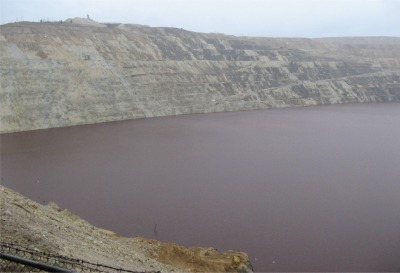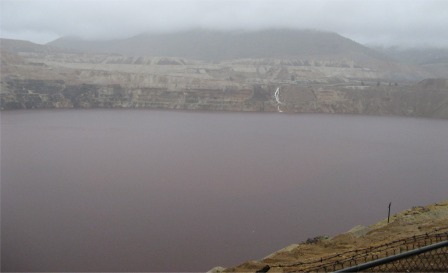 Two of the Many Pit Heads |
In the 1860s miners discovered gold and later silver there, however the rich pickings made using conventional prospecting techniques soon tailed off. Two entrepreneurs, William Clark and Marcus Daly moved in to develop the mines, and immediately realised the potential for the mining of the huge local copper deposits too; copper had traditionally been used to make pots, pans and jewelry, but with the advent of the telegraph, was becoming more in demand. Miners from around the world poured in and the town's population expanded from 250 in 1870 to 22,000 by 1885. Cornish miners introduced the pasty, still a popular local dish, and the Italian and Ukrainian miners brought facets of their culture across too, but the bulk of the miners were Irish. Initially the copper was mined and smelted in Butte, the smelting process producing so much pollution that trees could not grow and street lamps had to be left on continuously. However, the smelting was eventually moved to the nearby town of Anaconda.
Today, the historic section of Butte looks like any run down industrial town from northern England with boarded up buildings, a lack of paint, and stark gray or red business premises. However, closer inspection of the buildings that are open reveal that a lot of it has been kept as it was since its heyday in the early part of the 20th century, when the town was booming with a population of more than 100,000. The town appeared to be frozen in time. This became more apparent when I went on a guided walking tour around Historic Butte. This lack of change was unintentional, just the way the town has not evolved.
I entered the shop where the tour could be booked, and the crabby old woman reeled out her standard patter without a trace of a smile. I volunteered for the next tour. A sixth sense made me aware of a character sitting not too far away staring in my direction, with no flicker of eye movement or trace of breathing. In fact I couldn't be sure whether the character was a manikin. I paid for my ticket and a voice caught my attention, "Where are you from?". I turned, it was the manikin, and it spoke and actually moved. I sidled over and introduced myself. His name was Kevin, and he would be my tour guide. Kevin had a ruddy complexion, russet hair and was about 12 months pregnant. I learnt he had Irish roots in the Cork area, and his father had come across to mine. Once he understood that I had mining connections too, we got on fine.
The tour was not about mining specifically, but about the historic town and its inhabitants. He reeled off the standard fact sheet: mines started in 1864, 10,000 miles of tunnels under the hill, seams as far as a mile down, 30 - 40 mines working at one point on the hill, 24 billion pounds weight of copper mined plus all the other metals. At a total value for all the minerals mined of $162B, the town was labeled "the richest town on Earth". We set off down the main street, aptly named Main Street, and he pointed out in the distance to the sole mining operation still being undertaken in the town, an opencast mine called the Continental Pit. This was experiencing good times at the moment since the price of copper in the US was high due to the war in Afghanistan; shell casings contain a lot of copper. Kevin revealed a little of the Irish history here too. When an Irish miner was killed in the mine, other Irish miners would take his body out of the coffin and bury it in the hillside. They would then fill up the coffin with guns and rifles, shoot a dog and put it on top of the weapons, seal it and send it back to the mother-land. That was their method for exporting weapons back to Ireland.
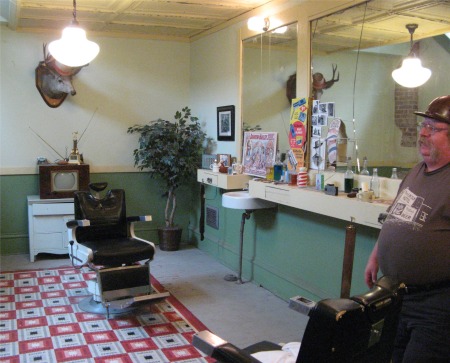 Basement Barbers Shop - Kevin to the Right |
This barber's shop dated way back and I was fascinated. But more was to come. The unusual feature in this shop was a safe in the corner, the safe door being door sized. He walked over and opened it, inside was a small cloak room with a couple of coats hanging up. Nothing unusual I thought, but why hang coats in a safe? Then he pulled a lever, and another door swung open into a concealed room. We walked inside into a make shift bar. This was set up during the prohibition years. We then explored the escape route should the case arise. Other parts of the basement were slowly being excavated since rubble had been dumped in areas. However, Kevin pointed out that there was no funding to help out here.
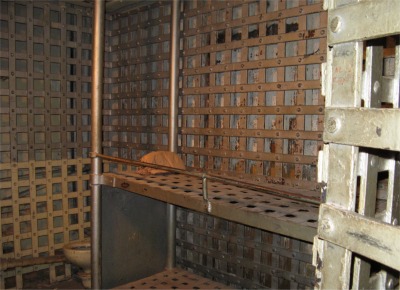 One of the Cells in the Town Gaol |
Our final port of call was an old hotel with interior walls covered in fine Italian marble. This had declined from being a grand hotel, to apartments and now seemed to be deserted. We went downstairs where we arrived at a door with a small three inch square hole at eye level. Kevin led me through into a cosy bar with several round tables with red tablecloths over them, a card table, a board marked up for the baseball scores, and in the corner a jazz band would have played at one time. This was again another secret room which was more for mining officials and other leading lights rather than the miners. Kevin took me around the corner from the door where we entered, and lifted a photograph. Behind it was a small pane of one-way glass. The procedure was a visitor would knock on the door, the barman would inspect the visitor through the one-way pane, and if it wasn't an unwelcome guest such as the FBI, he would return to the door and slide back a sheet off wood so allowing him to talk through the square hole at eye level. In a hushed voice he would request a password from the visitor by saying "speak easy", meaning respond in a similar hushed voice so that nobody can overhear. If the visitor had the right password, he was in. This is where the term speak easy came from, and this was a speak easy joint. This room had been preserved exactly from when it was boarded up. I was amazed by it all. Kevin was also a bit of a singer; must be the Irish blood. He entertained me with a couple of mining folk songs whilst in the bar. He would also be singing at the Copper King Mansion later in the day.
During the decline, many buildings mysteriously burned down, and the insurance companies had to take the hit. Still a fair number of buildings exist, which give a hint of what Historic Butte must have been like during its heyday. The trip was thoroughly enjoyable and informative. As I bade farewell to Kevin, he recommended I go to Gamer's and try the pasties there. I did, and it was delicious. Gamer's was a cafe from a forgotten time.
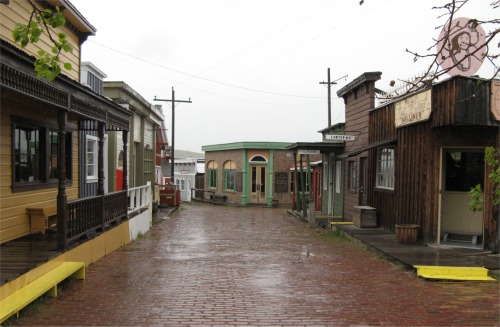 Hell Roarin' Gulch |
|
|
By 1975, all of Butte's underground operations were phased out because of low grade ore and escalating production costs. The Berkeley Pit was opened by the Anaconda Mining Company in 1955. Open cast mining became the primary method of operating because it permitted the bulk removal of low grade ores. Berkeley was 1800 feet at its deepest point. It was more than a mile wide and a mile and a half long. Huge excavating devices were used to extract the ore, the trucks were capable of carrying 170 tons each. In early 1982, mining ceased in the Berkeley Pit and Anaconda Mining Co. moved its mining operations to a new pit. Water from surrounding mine workings gradually leaked into the pit, which was now a lake. However, the lake was highly toxic, and Anaconda Richfield Co. and BP have been tasked with the job of clearing up the mess. This would take decades.
I left the Berkeley Pit viewing area, it was still pouring down and late afternoon. I didn't want to walk around the old town in the rain, so I sat in the van and started typing up what you have just been reading. I usually used whatever dead time I had to make notes and type. I am not the world's quickest typist, it takes a while. After a while, there was a knock on the van window. I looked out and saw two policemen, they wanted to know what I was doing there. I explained I was typing up a blog. They had received complaints that I had been parked in the pit car park too long. There also seemed to be some confusion about a red jacket, did I own one or did a passenger own one. I said I didn't, and I had no passenger. Somebody in a red jacket had gone into the gift shop and said they would return to buy a shirt, was I or a passenger that person. No!. But you have been here four hours. No, I was at Gamer's at 2pm, talk to the manager who I chatted to, then I went to the mining museum for quite a while, here is my ticket, then I came here to see the open cast mine, here is my ticket, and by the way look at the photos that I took, which are time stamped. It is now 6pm, so I haven't been here for four hours. Pregnant pause. So you are just typing sir? Yes. They let me be. I carried on typing, they sat in their car. Five minutes later along came another knock, I was perceived as a threat and could I move over to the parking lot across the road. OK. I drove across and parked on some derelict land. I felt as though I was a juvenile who had just been moved on by the police, a degrading experience. Along comes the policeman again. Sorry sir, this is private land, please follow me. I followed him to a car park and he left me in peace. I was really rattled by this, I absolutely hate being accused of things that I am innocent of. I was also worried that I may now be on a police file, perhaps banned from entering the country again. It shook me up, even though it was obviously a complete misunderstanding. Perhaps I did upset the girl in the kiosk????
I found a campsite actually within the sprawling Butte Flats part of town; not very attractive surroundings, but it would do for the night. It was chucking it down and I was in no mood for cooking, so I got advice from the camp officials and drove a few blocks to a restaurant. I sat at the bar and a young lad came up, "What would you like to drink, sir?". "Orange juice please and no ice, I'm driving." Then it was time to order food. The young lad sidled up, he was so sickly sweet with his presentation. He rattled off all the specials of the day like a walking, rapid talking menu; no pause for breath, the smile was fixed. No, I didn't fancy the vast gastronomic range of specials. I chose something simple off the menu. At this the lad launched into another series of verbal drop down menus about salad, salad dressings, steamed vegetables, treacle coated antennae from the planet Mars and body parts from exhumed bodies. It was all delivered with such ease and speed it was unbelievable, and always with the sickly smile. I wanted something between the surly kiosk girl and the sick, slick, sweetness of this lad. I don't ask for much, do I? An older guy behind the bar sidled up, "You're from England aren't you. I think you must be from Manchester way". This guy was good and I complimented him. I explained to him my travels around England and how my vowels had changed a lot, but the northern twang was still detectable, and he was near the mark. He had connections with the UK at one time through the Air Force. I was impressed. I left Mr. Smiley a tip, for which he profusely thanked me. In a way, if he had been rubbing his hands together he would have made an excellent Uriah Heep.
It was still belting it down, and I was still wound up and didn't feel like sleeping. Since Butte was over a mile above sea level, it was already chilly. Yet another cold night. Still, I would be heading south in the morning, and I'd be glad to escape the persecutions.

